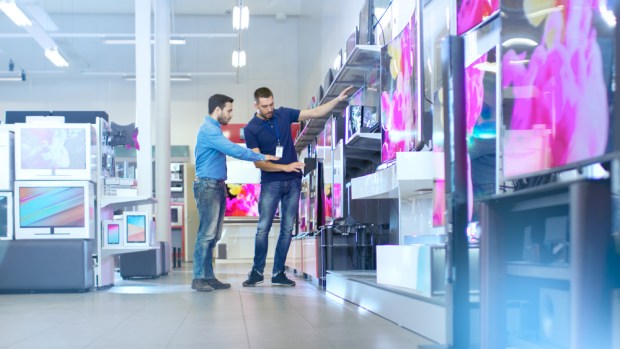The Digital Secret To Storefront ‘Surprise And Delight’

Brick-and-mortar retailers have an opportunity to surprise and delight shoppers with digital, connected and omnichannel experiences in the physical store, but many are struggling to make that opportunity pay off. To be fair, reimagining an entire industry is no easy task.
Trevor Sumner, CEO of PERCH, said that people aren’t seeing TV ads anymore, and active engagement between brands and their customers on Facebook is dwarfed by the number of shoppers who pass by a store display on any given day. If sales depend on customers having downloaded the store’s mobile app, he said, then the brand is only reaching about 10 percent of its shopper base — and besides, do they really want customers to be looking at their phones as they browse the store?
In short, said Sumner, marketing isn’t hitting shoppers when and where it needs to.
On top of that, consumers are more educated than ever before. Studies show that shoppers believe they know more than sales associates about the products they’re buying — and, thanks to Google, social media and digital campaigns, they may be right. Every brand is vying for attention with video and direct-to-consumer digital media. Yet none of that is making it into the physical retail environment.
For the brands whose products sit on the shelves of those stores, it must be frustrating to invest so heavily in digital marketing, only to have it deliver little to no ROI (return on investment) when customers are actually standing in front of a shelf, trying to decide which toothpaste, hair dye, lipstick or fragrance to buy.
There’s no differentiation in a store aisle, Sumner said. Every toothpaste declares its “advanced whitening” powers, but that doesn’t make the decision between Crest or Colgate any easier. The home hair coloring aisle is an endless paper box procession of men’s and women’s faces framed by different colors of hair. As for lipstick, customers can basically try on one color before making a decision.
“Your greatest captive audience is right in front of your product and ready to buy right now,” Sumner said. The trick is catching their attention when it matters with an experience that surprises and delights.
Start with Surprise
“The first part of ‘surprise and delight,’” Sumner said, “is surprise.”
What’s more surprising than picking up the item they’re thinking about buying, only to be presented with a digital, visual experience featuring the very product in their hand — right in front of them, no app necessary, no barcode scanning required? That’s the experience PERCH aims to deliver using computer vision and sensing technology to determine what the customer has picked up.
If customers aren’t absolutely delighted as well as surprised, there’s no commitment to watch the full display; walking away is easy and free. Yet in Sumner’s experience, people do watch the displays — and what’s more, they’re swayed by it.
It’s not just pretty animations of blackberries or sage behind bottles of perfume. Sumner said the content can (and should) educate customers about the product. After all, they’re about to make a decision on whether to buy this product or one by a competitor.
Instead of reading the product details in static four-point font on the packaging, Sumner said customers can learn all they need to know in a way that feels natural and engaging, and brands that have invested in visuals or celebrity endorsements can get more eyeballs on that content.
Sumner said this is especially important for categories like electronics — try learning everything there is to know about an iPhone from three bullet points on a tag at BestBuy! — as well as beverages, where margins are high and origin stories are of particular value, as consumers wish to justify spending more for a particular type of bourbon or wine.
Sumner also noted that consumer packaged goods is a crowded marketplace, where brands struggle to stand out. There’s an ongoing grocery store battle for more customers, since that is the most frequent point of purchase. In that environment, he said, the element of surprise can go a long way.
AR Best Practices
Augmented reality (AR) is a growing strategy across the retail industry, as brands like Sephora innovate ways for customers to try on infinite shades of lipstick — including ones that aren’t in the store, which can be digitally ordered on the spot if shoppers like them.
Sumner said this encourages customers to venture outside their comfort zones with shades they wouldn’t normally wear. Meanwhile, Kate Spade lets shoppers customize their own purses and emails them their unique styles, which customers can then order online and have delivered to their homes.
This AR-driven omnichannel ordering approach relieves two friction points, according to Sumner. Selection is the obvious one: Shelf space is limited, but, with a digital component, inventory becomes infinite. Payments can also be a major friction point, he said. Integrating experiential shopping displays into the store’s payment system lets customers access that infinite inventory at the moment they’re ready to make a purchase.
For AR to succeed, though, there are a few best practices that Sumner recommends.
Think about the shopper’s journey, he said. Consider how customers browse and explore. Not all of them will have the brand’s bespoke mobile app, but every shopper picks up products. By making that the trigger point, PERCH simply enhances what the customer is already doing.
Which dovetails into Sumner’s second best practice: Don’t require customers to learn new behavior. If they have to scan a product’s RFID tag to initiate the experience, there will be a drop-off in participation because nobody knows the experience is available to them, he said.
The key, he said, is to naturally integrate experiences into what the customer does already. Digital shopping has its advantages, but there’s no reason brick-and-mortar retail can’t leverage the same digital content to drive sales in physical environments as well, driving the top and bottom line.
